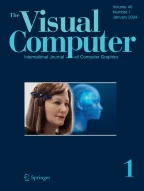Abstract
In this paper, we propose a new approach based on a particle-based model for ice melting simulation. Each particle has an attribute called virtual water. The amount of the virtual water of an ice particle indicates the amount of water surrounding the ice particle. The transfer of the virtual water is performed between the exterior ice particles so as to simulate the thin layer of water flow on the surface. Our approach also handles the transition between the virtual water and the water particles. We compute the isosurface of a density field defined by the ice particles and the virtual water. A simple ray tracing method is adopted for rendering the objects. We report the experimental results of several ice melting simulations with water flow and water drops.
Similar content being viewed by others
Explore related subjects
Discover the latest articles, news and stories from top researchers in related subjects.References
Arash, O.E., Génevaux, O., Habibi, A., Dischler, J.M.: Simulating fluid–solid interaction. In: Graphics Interface, pp. 31–38 (2003)
Clavet, S., Beaudoin, P., Poulin, P.: Particle-based viscoelastic fluid simulation. In: ACM SIGGRAPH/Eurographics Symposium on Computer Animation, pp. 219–228 (2005)
Chen, S., Merriman, B., Osher, S., Smereka, P.: A simple level set method for solving Stefan problems. J. Comput. Phys. 135, 8–29 (1997)
Fujishiro, I., Aoki, E.: Volume graphics modeling of ice thawing. In: Volume Graphics, pp. 69–80 (2001)
Foster, N., Fedkiw, R.: Practical animation of liquids. In: ACM SIGGRAPH, pp. 23–30 (2001)
Fujisawa, M., Miura, K.T.: Animation of ice melting phenomenon based on thermodynamics with thermal radiation. In: GRAPHITE, pp. 249–256 (2007)
Iwasaki, K., Uchida, H., Dobashi, Y., Nishita, T.: Fast particle-based visual simulation of ice melting. Comput. Graph. Forum 29, 2215–2223 (2010)
Kanamori, Y., Szego, Z., Nishita, T.: GPU-based fast ray casting for a large number of metaballs. Comput. Graph. Forum vol. 27, 351–360 (2008)
Lauterbach, C., Garland, M., Sengupta, S., Luebke, D., Manocha, D.: Fast BVH construction on GPUs. In: Comput. Graph. Forum 28, 375–384 (2009)
Losasso, F., Irving, G., Guendelman, F., Fedkiw, R.: Melting and burning solids into liquids and gases. IEEE Trans. Vis. Comput. Graph. 12(3), 343–352 (2006)
Madrazo, C., Tsuchiya, T., Sawano, H., Koyanagi, K.: Air bubbles in ice by simulating freezing phenomenon. J. Soc. Art Sci. 8(1), 35–42 (2009)
Nishita, T., Nakamae, E.: A method for displaying metaballs by using Bézier clipping. Comput. Graph. Forum 13, 271–280 (1994)
Nooruddin, F., Turk, G.: Simplification and repair of polygonal models using volumetric techniques. IEEE Trans. Vis. Comput. Graph. 2, 191–205 (2003)
Solenthaler, B., Schläfli, J., Pajarola, R.: A unified particle model for fluid-solid interactions. Comput. Animat. Virtual Worlds 18, 69–82 (2007)
Terzopoulos, D., Platt, J., Fleischer, K.: Heating and melting deformable models. J. Vis. Comput. Animat. 2(2), 68–73 (1991)
Wojtan, C., Carlson, M., Mucha, P.J., Turk, G.: Animating corrosion and erosion. In: EurographicsWorkshop on Natural Phenomena, pp. 15–22 (2007)
Zhao, Y., Wang, L., Qiu, F., Kaufman, A., Mueller, K.: Melting and flowing in multiphase environment. In: Compute and Graphics, vol. 30, pp. 519–528 (2006)
Acknowledgements
This work was supported by the National Science Council of ROC (Taiwan) (NSC-101-2221-E-009-157).
Author information
Authors and Affiliations
Corresponding author
Electronic Supplementary Material
Appendix A: Density function
Appendix A: Density function
The density function Φ(x) is defined in the form
where r=|x−x a |, h is the particle interactive radius, X a is the total volume of ice particle a (i.e. X a =V a +Z a ); and f is a function of volume and f(V init)=1. Consider a single ice particle and its total volume is X. The threshold is set to θ. Then the isosurface is a sphere and its radius R is computed as \(R = (1-\frac{\theta}{f(X)})h\). Based on the volume ratio of two spheres with and without virtual water, we should have
We rearrange the terms to obtain f(X):
For X close to V init and θ=0.5, \(f(X) \approx\sqrt[3]{\frac{X}{V_{\mathrm{init}}}}\). This can be shown by using Taylor expansion.
Rights and permissions
About this article
Cite this article
Lii, SY., Wong, SK. Ice melting simulation with water flow handling. Vis Comput 30, 531–538 (2014). https://doi.org/10.1007/s00371-013-0878-1
Published:
Issue Date:
DOI: https://doi.org/10.1007/s00371-013-0878-1
